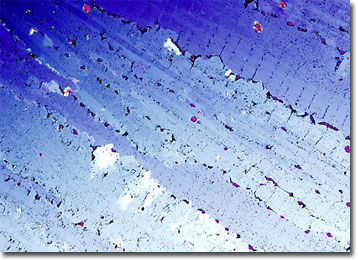Polarized Light Microscopy Digital Image Gallery
Mycostatin
An antifungal agent and antibiotic, Mycostatin is utilized to remedy a variety of conditions, but is most popular as a treatment of skin and mucosal membrane infections caused by the yeast-like fungus Candida albicans. The effective drug is available in a variety of forms, including powders, lozenges, tablets, and creams.

Mycostatin is a brand name for the generic drug nystatin, which was first developed by New York Department of Health researchers Elizabeth Lee Hazen and Rachel Fuller Brown. Since it was patented in 1957, the antifungal antibiotic has helped cure countless humans suffering from a variety of fungal infections, such as thrush and intestinal candidiasis. In addition, nystatin has been utilized for a number of less well-known applications, such as treatment of Dutch Elm’s disease and the restoration of artwork damaged by mold. In return for their significant achievement, Hazen and Fuller were inducted into the National Inventors Hall of Fame in 1994, but what is perhaps more remarkable is the fact that the women donated all of the profits from their invention to a nonprofit organization that supports the advancement of academic studies in science.
Derived from the soil fungi actinomycete Streptomyces noursei, Mycostatin and other brands of nystatin, such as Nadostine, Nilstat, and Nystex, work by interacting with ergosterol, a steroid present in the cellular membrane of fungi. This interaction alters the permeability of the membrane, resulting in leakage of cellular contents and the eventual destruction of the treated fungus. Due to its mode of action, Mycostatin does not affect most types of bacteria because they do not generally contain the same types of steroids in the membranes of their cells. The most common side effects reported from Mycostatin use include nausea, diarrhea, and stomach pain.
